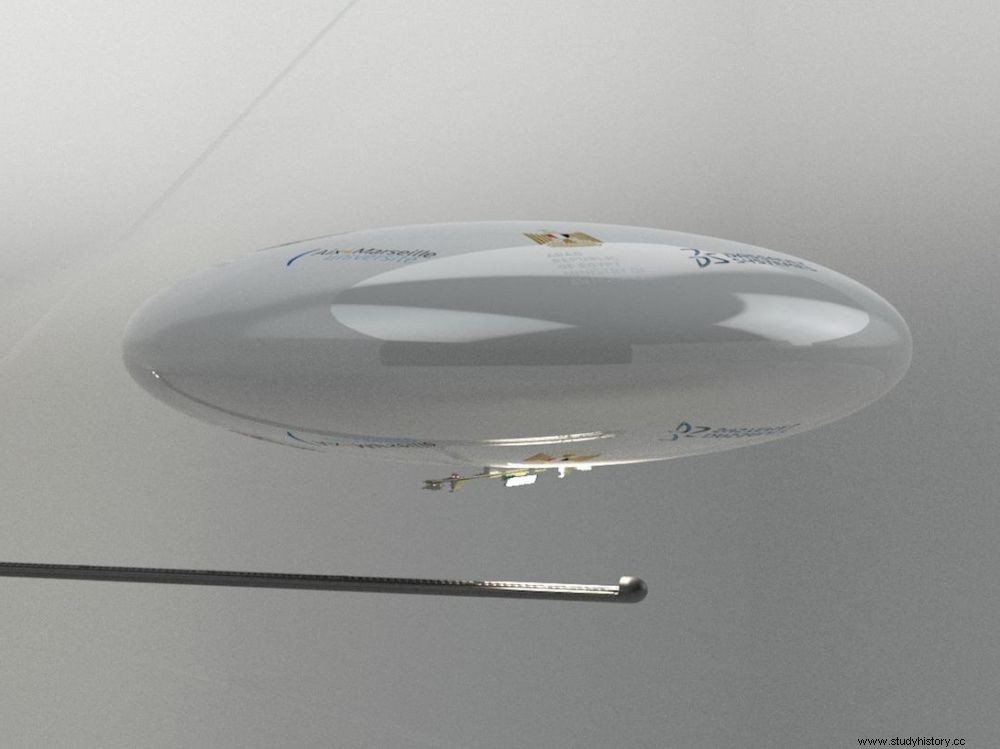The CNRS and Inria have joined the ScanPyramids mission to develop a robotic concept that is as least invasive as possible to explore hard-to-reach places such as the Cheops pyramid.

The folded robot can slip through a 3.5 cm diameter hole drilled in a wall, to deploy on the other side taking the form of an 80 cm inflatable balloon.
CAVITY . Since the discovery, in the heart of Kheops, of an immense cavity, everyone has dreamed of it! A mini-robot capable of penetrating from the smallest possible hole in the bowels of the great pyramid. And to go and see what she still hides. This announcement made on November 29, 2017 by Inria and the CNRS is therefore excellent news. The two scientific institutions have joined the ScanPyramids mission, which discovered the mysterious void, to develop the concept of a "minimally invasive" exploration device.
Jean-Baptiste Mouret, Inria researcher in the Larsen* team, is leading the project. “For now, the idea is not to send a robot into Kheops, insists the specialist in artificial intelligence. But to take advantage of this international mission to imagine other ways of studying heritage .” Launched in 2015 by the HIP Institute (Heritage, Innovation, Preservation) and Cairo University, ScanPyramids has indeed become a real laboratory for the archeology of the future, mobilizing the most innovative technologies - simulation, virtual reality and above all muography – around the funerary monuments of the IV th dynasty. Bertrand Duplat, inventor-engineer and scientific advisor to the mission, also participated in the invention of the robotic concept with Jean-Baptiste Mouret.
This must be developed in two stages. First a tubular robot small enough to be inserted into a hole with a diameter of less than 3.5 centimeters. Equipped with a torch and an adjustable high-definition camera, it will be able to take pictures 15,000 pixels wide, while allowing scientists to scan every corner of the space studied. “It will have a reconnaissance mission so that we know if it is adequate to send a crawler next ”, emphasizes Jean-Baptiste Mouret.
This second robot represents the most spectacular stage of the concept. Because it is a flying machine that must also be able to slip through a 3.5 centimeter hole. The team is currently working on the design of a miniature airship. This, folded inside a tube, would be inflated from a distance once it reached the cavity. It could then leave its base to evolve in space like a spaceship. Before returning there, its mission completed, in order to be deflated and then extracted from the cavity thanks to the tubular structure. Directed by radio, equipped with four motors, several light sources, a camera, a small on-board computer and a whole range of sensors, the machine should have a payload of barely 50 grams.
Researchers were inspired by the movement of bees
“To be able to perform all these maneuvers, the robot relies on the bio-mimetic sensors designed at the Institute of Movement Sciences (CNRS/Aix-Marseille University), explains Jean-Baptiste Mouret. The researchers were inspired by the movement of flies and bees which, placed in a corridor, move by measuring the optical flow, i.e. the speed of scrolling of objects on their retinas. The small electronic sensors of the future robot should implement the same technique. He will thus be able to move around independently and return to his base on his own if he loses the radio connection. ”
The deployment of the nacelle at the exit of the tube remains the biggest challenge for the team. It will still take months – if not years – to perfect this sci-fi contraption. The first robot, meanwhile, already exists as a prototype. And we like to imagine, despite the caution displayed by the team, that with the authorization of the Egyptian authorities, it could be used in Kheops. Because if the famous cavity discovered by ScanPyramids seems inaccessible, so deep is it in the stone massif, the mission has also identified the beginning of a corridor, just behind the rafters of the north face. But this one is located exactly in the same axis as her. Introducing a mini robot equipped with a camera would perhaps make it possible to know if the corridor continues in its direction. Offering an unexpected entry point.
* Joint Inria/CNRS/University of Lorraine team.
